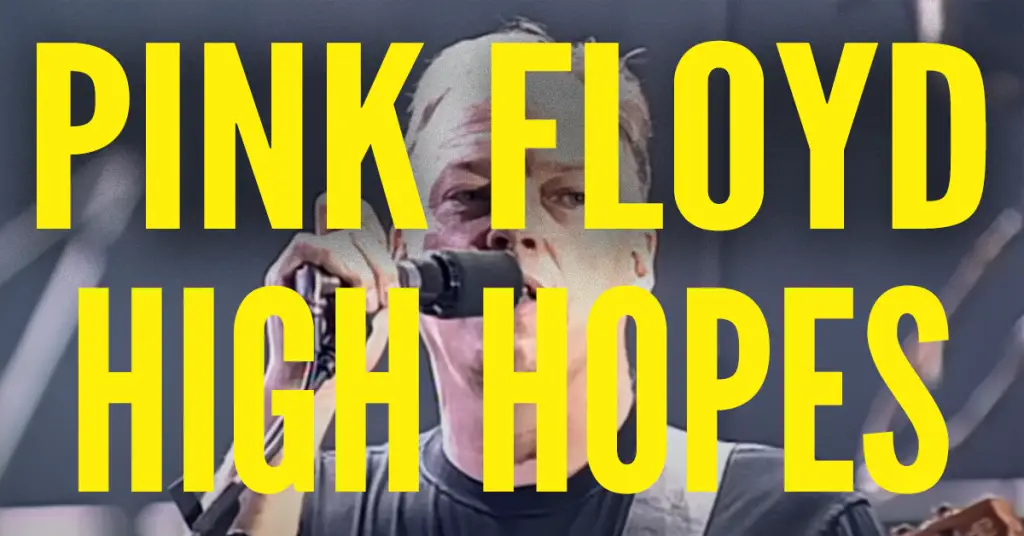Pink Floyd – “High Hopes”: The Final Toll of a Bell and the Echo of Lost Dreams
There are songs that end albums—and then there are songs that close a chapter, fold it in velvet, and seal it with a sigh. “High Hopes,” the final track on The Division Bell (1994), is exactly that. For many fans, it feels like Pink Floyd’s true goodbye: a farewell wrapped in elegy, memory, and unresolved longing.
With haunting lyrics, a mournful bell toll, and one of David Gilmour’s most soul-stirring guitar solos, “High Hopes” stands as one of the band’s most emotionally resonant songs—a meditation on ambition, regret, and the passage of time.
The Atmosphere: Shadows and Soundscapes
From the opening clang of a distant church bell, “High Hopes” sets a mood of solemnity and reflection. The piano begins—simple, sparse—and is soon joined by Gilmour’s weary, gentle vocals, heavy with the weight of looking back.
“Beyond the horizon of the place we lived when we were young…”
The song slowly unfolds like a foggy memory, with lush production, subtle orchestration, and ambient sound effects that place you in the English countryside, in the fading light of dusk.
This is Pink Floyd in their most cinematic, melancholic form. Not abstract. Not psychedelic. But deeply personal.
The Lyrics: A Journey Through Time and Memory
Written by David Gilmour and Polly Samson, the lyrics of “High Hopes” explore the tension between youthful ambition and adult disillusionment. They speak of paths not taken, bridges burned, and the inevitable distance between dreams and reality.
“The grass was greener, the light was brighter…”
“With friends surrounded, the nights of wonder…”
It’s hard not to read these lines as Gilmour’s own reflection on Pink Floyd’s long and complicated history—especially his relationship with estranged former bandmate Roger Waters. But the song also speaks more universally, tapping into that aching familiarity of looking back and wondering:
Was the best behind us? Or is there still something ahead?
The final verse offers no answer—just a return to the tolling bell, and the image of a road that continues, forever parting from what once was.
The Guitar Solo: A Cry from the Soul
When words are no longer enough, Gilmour’s guitar takes over—and what a solo it is. Often hailed as one of his finest, it rises slowly from the silence and soars with aching beauty. It’s not flashy, not technical—it’s felt, every note stretched to the edge of breaking.
The solo mirrors the emotion of the song: longing, loss, and just the faintest trace of hope.
It’s the sound of a man saying goodbye—not with rage, not with regret, but with quiet reverence.
The Division Bell and the End of an Era
The Division Bell marked Pink Floyd’s final studio album with David Gilmour, Richard Wright, and Nick Mason. It was a record about communication, miscommunication, and the distances between people, especially those who once shared everything.
“High Hopes” served as the final track, and for nearly 20 years, it stood as the band’s final word. Even with the surprise release of The Endless River in 2014 (a mostly instrumental tribute to Wright), nothing has ever matched the emotional closure of “High Hopes.”
Legacy: A Song That Keeps Echoing
“High Hopes” has grown in stature over time. It is now considered one of Pink Floyd’s great later-career masterpieces, and a live staple in Gilmour’s solo tours. Its video, with surreal English imagery and haunting symbolism, only deepens its mythic quality.
In a band that gave us “Time,” “Wish You Were Here,” and “Comfortably Numb,” “High Hopes” earns its place among the most profound and affecting.

Final Thoughts
“High Hopes” is more than just the end of an album.
It’s a farewell letter to youth, to friends lost, to the ideals that fade with age.
It doesn’t rage against the dying light—it walks slowly toward it, eyes open.
In the end, there’s no great revelation.
Just the echo of bells, a road that goes ever on,
and a voice reminding us that all things change—even dreams.


Facebook Comments